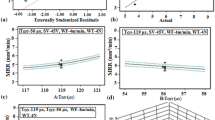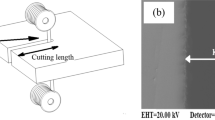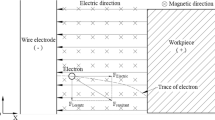Abstract
Microscopic changes in the surface of nickel-titanium (nitinol) shape memory alloys (SMAs) in micro-wire electro-discharge machining (μ-WEDM) due to the formation of a resolidified layer on the machined surface, called white layer, are one of the main drawbacks in the processing of such alloys. Since these changes significantly affect the shape memory and elastic recovery characteristics of these alloys, reduction of the white layer thickness (WLT) based on the selection of optimum process parameters is essential to raise the quality of the machined parts. In this regard, a finite element model (FEM) has been developed to simulate the effects of μ-WEDM process parameters, including discharge current, pulse on-time, pulse off-time, and servo voltage, on the heat distributing in Ni55.8Ti SMA to predict the WLT. The flushing efficiency of electric discharges and the effect of flow regime of the dielectric fluid on the heat distribution in the workpiece and the formation of the WLT are analyzed. Experimental data are used to verify the accuracy of the FEM. The results show that the developed model can predict the WLT in μ-WEDM process of Ni55.8Ti SMA with an average error of 14%. The effects of discharge parameters on the formation of the WLT are discussed in details based on the results of the FEM.
















Similar content being viewed by others
Data availability
Data are available within the article and supplementary materials will be available on request from the corresponding author.
Abbreviations
- A p :
-
Cross section of gap entrance (mμ)
- C P,f :
-
Specific heat of fluid in constant pressure (J/kg K)
- D :
-
Diameter of wire electrode (m)
- D c :
-
Depth of molten crater
- D h :
-
Hydraulic diameter (m)
- f w :
-
Energy fraction of workpiece
- f tur :
-
Friction factor of turbulent flow
- h :
-
Gap between cutting wire and kerf wall (μm)
- h C :
-
Convection heat transfer coefficient (W/mμ K)
- I d :
-
Discharge current (A)
- k :
-
Thermal conductivity of workpiece (W/m K)
- k f :
-
Thermal conductivity of fluid (W/m K)
- KW :
-
Kerf width (μm)
- Nu :
-
Nusselt number
- P :
-
Wetted perimeter of micro-channel (m)
- PFE% :
-
Plasma flushing efficiency (%)
- Pr :
-
Prandtl number
- q :
-
Heat flux (W/m2)
- R a :
-
Arithmetic average surface roughness (μm)
- Re :
-
Reynolds number
- R i :
-
Radius of plasma channel
- r,z :
-
Polar coordinate axes
- T :
-
Temperature (°C)
- t :
-
Time (s)
- T o :
-
Initial temperature of workpiece (°C)
- T on :
-
Pulse on-time (μs)
- T s :
-
Surface temperature of workpiece (°C)
- U :
-
Discharge voltage (V)
- V :
-
Average velocity (m/s)
- V c(FEM):
-
Volume of molten crater obtained by FEM (μm3)
- WLT(EXP):
-
White layer thickness obtained by experiments (μm)
- WLT(FEM):
-
White layer thickness obtained by FEM (μm)
- x W :
-
width of workpiece (mm)
- α :
-
Thermal diffusivity (m2/s)
- μ f :
-
Dynamic viscosity of fluid (N s/m2)
- ρ f :
-
Density of fluid (kg/m3)
References
Hartl DJ, Lagoudas DC (2007) Aerospace applications of shape memory alloys. Proc Inst Mech Eng G J Aerosp Eng 221:535–552
Ryhänen J (1999) Biocompatibility evaluation of nickel-titanium shape memory metal alloy, Ph.D. Thesis, University of Oulu.
Xiong JY, Li YC, Wang XJ, Hodgson PD, Wen CE (2008) Titanium–nickel shape memory alloy foams for bone tissue engineering. J Mech Behav Biomed Mater 1(3):269–273
Sharma N, Raj T, Kumar KJ (2017) Parameter optimization and experimental study on wire electrical discharge machining of porous Ni40Ti60 alloy. Proc Inst Mech Eng B J Eng Manuf 231(6):956–970
Puri AB (2017) Advancements in micro wire-cut electrical discharge machining. In: Kibria G, Bhattacharyya B, Davim J (eds) Non-traditional micromachining processes. Materials Forming, Machining and Tribology. Springer, Cham
Guo Y, Klink A, Fu C, Snyder J (2013) Machinability and surface integrity of Nitinol shape memory alloy. CIRP Ann 62:83–86
Ezugwu EO, Bonney J, Yamane Y (2003) An overview of the machinability of aeroengine alloys. J Mater Process Technol 134(2):233–253
Ulutan D, Ozel T (2011) Machining induced surface integrity in titanium and nickel alloys: A review. Int J Mach Tools Manuf 51(3):250–280
Markopoulos AP, Pressas IS, Manolakos DE (2015) A review on the machining of nickel-titanium shape memory alloys. Rev Adv Mater Sci 42:28–35
Li C, Nikumb S, Wong F (2006) An optimal process of femtosecond laser cutting of NiTi shape memory alloy for fabrication of miniature devices. Opt Lasers Eng 44(10):1078–1087
Huang H, Zheng Y, Lim GC (2004) Femtosecond laser machining characteristics of Nitinol. Appl Surf Sci 228(1–4):201–206
Fu CH, Liu JF, Guo YB, Zhao QZ (2016) Comparative study on white layer properties by laser cutting vs. electrical discharge machining of nitinol shape memory alloy. Procedia CIRP 42:246–251
Kruth J, Stevens L, Froyen L, Lauwers B (1995) Study of the white layer of a surface machined by die-sinking electro-discharge machining. CIRP Ann Manuf Technol 44(1):169–172
Lee H, Tai TY (2003) Relationship between EDM parameters and surface crack formation. J Mater Process Technol 142(3):676–683
Mahtabi MJ, Yadollahi A, Rahmati M, Stone TW (2018) Correlation between hardness and loading transformation stress of superelastic NiTi. Arab J Sci Eng 43(9):5029–5033
Liu JF, Guo YB (2015) Process capability of wire-EDM of NiTi shape memory alloy at main cut and trim modes. Proc Manuf 1:904–914
Kedare R, Nanavare V, Sharma S, Midathada A, Ravella UK (2018) Review on WEDM of shape memory alloy. Mater Today: Proc 5(14):28313–28319
Lotfi Neyestanak AA, Daneshmand S (2013) The effect of operational cutting parameters on Nitinol-60 in wire electrodischarge machining. Adv Mater Sci Eng 2013:1–6
Hsieh SF, Chen SL, Lin HC, Lin MH, Chiou SY (2009) The machining characteristics and shape recoveryability of Ti–Ni–X (X ¼ Zr, Cr) ternary shape memory alloys using the wire electro-discharge machining. Int J Mach Tools Manuf 49:509–514
Saha S, Pachon M, Ghoshal A, Schulz MJ (2004) Finite element modeling and optimization to prevent wire breakage in electro-discharge machining. Mech Res Commun 31:451–463
Han F, Cheng G, Feng Z, Isago S (2008) Thermo-mechanical analysis and optimal tension control of micro wire electrode. Int J Mach Tools Manuf 48:922–931
Hou PJ, Guo YF, Sun LX, Deng GQ (2013) Simulation of temperature and thermal stress filed during reciprocating traveling WEDM of insulating ceramics. Proc CIRP 6:410–415
Kumar A, Bagal DK, Maity KP (2014) Numerical modeling of wire electrical discharge machining of super alloy Inconel 718. Process Eng 97:1512–1523
Giridharan A, Samuel GL (2015) Modeling and analysis of crater formation during wire electrical discharge turning (WEDT) process. Int J Adv Manuf Technol 77:1229–1247
Senkathir S, Sandeep KS (2018) Finite element modelling and machining using WEDM. IOP Conf Ser Mater Sci Eng 402:1–14
Najati Ilkhchi R, Shabgard M, Kabirinia F (2019) Numerical studying and experimental investigation: Effect of Reynolds number on performance measures of EDM with high speed flushing. J Manuf Process 48:228–235
Salonitis K, Stournaras A, Stavroupoulos P, Chryssolouris G (2009) Thermal modeling of the material removal rate and surface roughness for die-sinking EDM. Int J Adv Manuf Technol 40(3–4):316–323
Shabgard M, Ahmadi R, Seyedzavvar M, Nadimi Bavil Oliaei S (2013) Mathematical and numerical modeling of the effect of input-parameters on the flushing efficiency of plasma channel in EDM process. Int J Mach Tools Manuf 65:79–87
White FM (2013) Fluid mechanics. 4th edn, University of Rhode Island, McGraw-Hill, p348
Koch P (2008) Equivalent diameters of rectangular and oval ducts. Build Serv Eng 29(4):341–347
Stanford MK (2012) Thermophysical properties of 60-nitinol for mechanical component applications. NASA Cen. Aero. Inf., NASA/TM–216056.
Joshi SN, Pande SS (2011) Intelligent process modeling and optimization of die-sinking electric discharge machining. Appl Soft Comput 11:2743–2755
Jithin S, Raut A, Bhandarkar UV, Joshi SS (2018) FE modeling for single spark in EDM considering plasma flushing efficiency. Proc Manuf 26:617–628
Apurba V, Roy K, Kumar K (2014) Effect and optimization of various machine process parameters on the surface roughness in EDM for an EN41 material using Grey-Taguchi. Proc Mater Sci 6:383–390
Es-Souni M, Fischer-Brandies H (2002) On the properties of two binary NiTi shape memory alloys. Effects of surface finish on the corrosion behavior and in vitro biocompatibility. Biomaterial. 23(14):2887–2894
Kojima A, Natsu W, Kunieda M (2008) Spectroscopic measurement of arc plasma diameter in EDM. CIRP Ann Manuf Technol 57:203–207
Acknowledgments
The authors would like to thank the Micro System Design and Manufacturing Research Center and National Nanotechnology Research Center (UNAM) of Bilkent University for the WEDM and SEM measurements. Especially, we would like to thank the help of Professor Yigit Karpat and Dr. Şakir Baytaroğlu.
Author information
Authors and Affiliations
Contributions
Samet Akar and Mirsadegh Seyedzavvar have conceived the idea, designed the experiments, and analyzed the results and data. Reza Najati Ilkhchi conducted the finite element simulations. Samet Akara and Hassan Ali M. Meshri conducted the experiments and collected the data. Mirsadegh Seyedzavvar wrote the manuscript getting contribution from all authors.
Corresponding author
Ethics declarations
Ethical approval
Not applicable
Consent to participate
All authors of this work have significant contribution in this study and have participated in experiments, simulations, and analyses of the results and they attest to the validity of the data and its interpretations.
Consent to publish
Submission of this paper implies that if accepted it will not be published elsewhere, in English or in any other language, and Springer publisher is granted with the exclusive, permanent, and unlimited right to reproduce, publish, distribute, and transmit this paper.
Conflict of interest
The authors declare no competing interests.
Additional information
Publisher’s note
Springer Nature remains neutral with regard to jurisdictional claims in published maps and institutional affiliations.
Rights and permissions
About this article
Cite this article
Ilkhchi, R.N., Akar, S., Meshri, H.A.M. et al. Prediction of white layer formation in μ-WEDM process of NiTi shape memory superalloy: FEM with experimental verification. Int J Adv Manuf Technol 113, 2805–2817 (2021). https://doi.org/10.1007/s00170-021-06796-y
Received:
Accepted:
Published:
Issue Date:
DOI: https://doi.org/10.1007/s00170-021-06796-y




